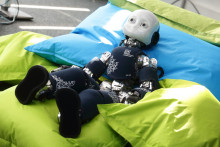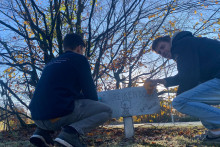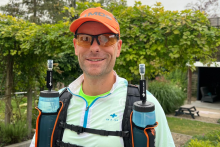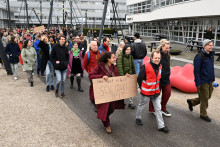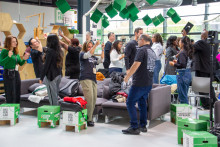Wendy Ju is the Executive Director of the Center for Design Research at Stanford University. Ju was invited to give a lecture at the symposium that focused on human-robot interactions. ‘I’m especially proud of our group’s field work and what we often call uncontrolled experiments, through which we try to determine how will the things we design work in the real world,’ Wendy Ju began her talk. ‘Field experiments are important because there are all kinds of crazy things happening every day that researchers can’t anticipate in a controlled setting.’
How do we react to a robotic trashcan? We talk to it.
Ju mentioned several field experiments that her team has conducted over the years. Many of them involved rather simple robots, everyday objects to which the researchers applied motion. One example was a robot trash barrel, which was driving around for people to throw trash into it or otherwise interact with it.
‘Yes, we will have personal robots, but moving everyday objects will be how robots will enter the world,’ explained Ju. ‘In the robot trash barrel experiment you can see that robot-human interactions are based on human interactions. We empathize and intuitively know how to react.’ As Ju showed in a video of the experiment, when seeing the robot, people instantly wanted to interact with it: they talked to it, tried to get its attention by waving trash around, they sometimes treated as a pet and they even helped it when needed.
Wizard of Oz protocol and autonomous cars
Autonomous cars are a hot topic right now. Will they work? How will people respond to them and how will they respond to people? ‘Autonomous vehicles are basically big robots that you sit in,’ said Wendy Ju. ‘We did an experiment using the Wizard of Oz protocol. Participants were put in a passenger seat of a regular car, but they were physically separated from the driver, who they couldn’t see, and they were asked to imagine that they were in a real self-driving car. Although they were clearly asked to only imagine the situation, later we realized that many participants thought they were in an actual autonomous car, hence their reactions.’
This real road autonomous driving simulation showed that people in autonomous cars still feel responsible and stressed, because they can’t influence what the car does. ‘Such a live action theatre is very useful for us. It helps us understand things that don’t exist yet and might matter in the future,’ clarified Ju, who now hopes to run similar experiments in many places around the world. ‘You can have the same self-driving car, but the behavior in it and around it is completely different in every culture.’


